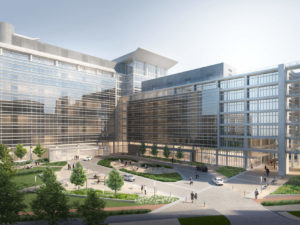This month we take a look at some recent data updates related to the labor force and employment data in Maryland. Generally, we see job gains in Maryland state and local government as well as some hard hit (but low wage) private industries but we find little to cheer about in the higher value-add industries.
Also, we look at a couple of key office submarkets. Bethesda/Chevy Chase remains the County’s most valuable submarket, though the gap between available space and vacant space indicates that we’ve got a ways to go before that submarket reaches supply/demand equilibrium. At the same time, North Rockville/Shady Grove continues to impress after two decades of stasis.
Maryland Labor Force – September 2021
Per the Local Area Unemployment Statistics, Maryland’s September employment situation generally resembled the August situation – the seasonally adjusted unemployment rate declined from 6.0% to 5.9% on the backs of very modest changes (for the better) in the number of unemployed and employed residents. Disappointing, though not per se negative, was the very small change in the labor force. On a seasonally adjusted basis (important when comparing August and September due to the end of summer employment), the Maryland labor force grew by fewer than 700. As I noted last month, we probably came into September with about 250,000 fewer Marylanders in the workforce than had been in the workforce pre-pandemic, and that remained the case at the beginning of October.
Looking at the Current Employment Statistics, overall non-farm payroll employment in Maryland increased by 1,200 from August to September though that was to some degree a result of increases in the public sector (local government employment statewide increased by 1,600 and state government by 1,200). Within the private sector, a lot of the gainers are industries at the low end of the wage scale – accommodation and food services showed some strength with an increase of 3,300 (again, on a seasonally adjusted basis), while retail trade jobs increased by 1,200. Administrative support and waste services increased by 1,600 as well.
On the flip side, weakness is evident in a couple of important Maryland industries: finance and insurance lost 1,400 jobs in September; and transportation, warehousing, and utilities lost 2,400 jobs. The former is significant because the finance and insurance industry is such an important piece of office demand and is a high value-add industry. The latter is significant because so much of the current demand in the marketplace is in transportation, logistics, and distribution facilities.
Montgomery County’s August unemployment rate of 5.6% represented a slight decline from July (5.7%, not seasonally adjusted) and was lower than Maryland overall. It will be interesting to see if the County remains on the same trajectory – trending down, and somewhat lower than the statewide numbers – when the next batch of county-level unemployment data comes out soon.
Maryland Personal Income – 2nd Quarter 2021
Second quarter personal income statistics indicate that the recovery remains limited and/or tenuous. For the United States, seasonally adjusted personal income dropped from the first to the second quarter of 2021 by 6.0%, while Maryland seasonally adjusted personal income declined by 5.6%. On a per capita basis, Maryland seasonally adjusted annual per capita income declined from $74,099 in the 1st quarter to $70,002 in the second quarter.
With respect to wages and salaries by place of work, the ebb and flow of wage and salary income is just one example of the uneven geographic recovery. For example, from the 4th quarter of 2020 to the 1st quarter of 2021 wage and salary income in the U.S. increased by only 4.0%, compared to 14.0% in Maryland. In contrast, from the 1st to 2nd quarters of 2021 the story was reversed – U.S. wage and salary income increased by 8.3% from quarter to quarter, while Maryland wage and salary income increased by only 4.6%.
Commercial Real Estate Market Trends
The Bethesda/Chevy Chase office market continues to be a mixed bag in terms of indicators – there are new projects nearing completion in the submarket and there have been some recent leasing successes; on the other hand, the large leases have been retentions (such as Walker & Dunlop and Enviva) and obvious drivers of new growth are hard to find outside of the biomedical office space that is being chased by submarkets throughout the County and by other leading bio office markets.
The overall vacancy rate of 18.8% is relatively high, though the rate of increase so far has been relatively slow. Perhaps more significant/worrying is that the availability rate has increased substantially during the pandemic, and now stands at 25.9%. This indicates that vacancy rates are likely to continue to climb over the next couple of years. Should vacancy rates continue to rise this will place additional pressure on office properties, retail and restaurant businesses, and the County’s property tax base.
Presenting a very different picture, the North Rockville/Shady Grove submarket has been hot from a capital markets perspective, with substantially more transaction volume than Bethesda. This is driven by the area’s bio-med focus, and by the fact that there remain value plays in the submarket. After a couple of decades of very little price pressure, rents and transaction values appear to be trending up.
From a capital markets perspective, I continue to be interested by the large and growing gap between cap rates in Montgomery County and those elsewhere in the region. The higher cap rates in Montgomery County (think of this as the inverse of the price/earnings ratio of a stock) indicate that capital markets perceive Montgomery County assets as generally riskier than those elsewhere in the region, whether because of the general trajectory of Montgomery County as a location for jobs, greater perceived political risk/uncertainty, or higher taxes. To illustrate, the cap rate for transactions involving newer, high-end office properties in D.C. is 5.4%, well below the cap rate of 7.5% for such properties in Montgomery County. This means that to a buyer, each dollar of net operating income (NOI) is worth 28% more in D.C. than it is in Montgomery County. That is before considering that the properties in D.C. generate rents that are substantially higher than those commanded by Montgomery County properties.
Most of the County’s downcounty and midcounty office properties will be re-assessed over the next two cycles, meaning that we’ll have a pretty good idea of the direction and magnitude of the pandemic’s effect on assessed values and property tax revenue by the time we get to January of 2023.
Supply Chain Woes – Anecdata Alert!
On a personal level, my recent bout with the so-called “common cold” (I was uncommonly miserable!) gave me some new personal insights and experiences with supply chain woes. At one point, my local CVS had no cough drops remaining on the shelf. The automated phone system would not give me a time that I could pick up my prescription (“we’re working on filling your prescription”), while the automated text message at one point indicated to me that my prescription would be “ready for pick up in 3 to 4 days.” I couldn’t call in to check the timing on the prescription because they don’t have enough staff to answer the phone. And when my wife went to the pharmacy to pick up the prescription, the pharmacist indicated that the single store had a backlog of 1,200 prescriptions to fill. Um, yikes?!?! Hang in there, folks. We’ve got a long way to go.
Be well, stay safe, and shop MoCo.


